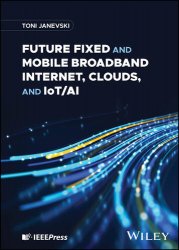 Название: Future Fixed and Mobile Broadband Internet, Clouds, and IoT/AI
Название: Future Fixed and Mobile Broadband Internet, Clouds, and IoT/AIАвтор: Toni Janevski
Издательство: Wiley-IEEE Press
Год: 2024
Страниц: 345
Язык: английский
Формат: pdf (true), epub
Размер: 26.7 MB
All-in-one resource on the development of Internet and telecoms worldwide, based on the technological frameworks as defined by the ITU.
Future Fixed and Mobile Broadband Internet, Clouds, and IoT/AI is a highly comprehensive resource that provides full coverage of existing and future fixed and mobile broadband networks, internet, and telecom and OTT services. This book explains how to perform technical, business, and regulatory analysis for future 5G-Advanced, 6G, WiFi, and optical access. This book also covers optical transport, submarine cable, future satellite broadband, cloud computing, massive and critical IoT and frameworks and use of AI / ML in telecommunications.
The main “form” of AI at the present time is Machine Learning (ML). ITU has defined architecture for ML in future networks including 5G/IMT‐2020 and beyond. What is ML? According to the ITU’s definition: Machine Learning refers to processes that enable computational systems to understand data and gain knowledge from it without necessarily being explicitly programmed. However, ML is based on mathematics and it is commonly implemented via software tools which are programmed (either by humans or by software tools developed by humans).
The ML model is created by applying Machine Learning techniques to data with the aim to learn from them. What is the purpose of the ML model? It is used to generate predictions (e.g. regression, classifi cation, clustering) on new (untrained) data. How is the ML model implemented? Typically, it is deployed in the form of software (e.g. virtual machine) or hardware component (e.g. IoT device). What do ML techniques include? They typically include certain learning algorithms that map the input data (which is used for feeding the ML) to output data. Normally, the type of data depends upon the use case (e.g. it is traffic data in a case of QoS management or network optimization).
Topics covered include:
Internet technologies, IPv6, QUIC, DNS, IPX, QoS in Internet/IP, cybersecurity, future Internet 2030, Internet governance
Future metallic and optical broadband, carrier-grade Ethernet, SD-WAN, OTN, submarine cable, satellite broadband, business and regulation of broadband
Future mobile and wireless broadband, 5G-Advanced, 5G/6G spectrum management, 5G Non-Terrestrial Networks, QoS, 6G/IMT-2030, WiFi 7 (802.11.be), mobile business and regulatory aspects
Cloud computing architectures and service models, MLaaS, BaaS, future OTT and telecom cloud services, business and regulation of clouds
Future voice, future TV, XR/AR/VR, critical IoT/AI services, future OTT services, metaverse, network neutrality, future digital economy and markets
Future Fixed and Mobile Broadband Internet, Clouds, and IoT/AIis an essential reference for government officials and regulators, business leaders, engineers, managers, and employees in the telecommunications industry, ICT business professionals, and students in telecommunications.
Скачать Future Fixed and Mobile Broadband Internet, Clouds, and IoT/AI